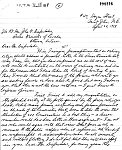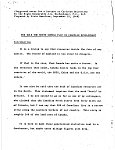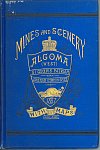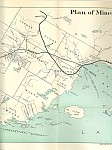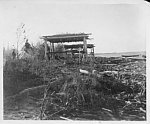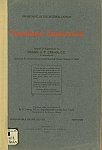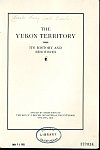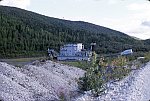Resources
Author: Tom Novosel Page 1 | Page 2 | Page 3
“Considering the tremendous resource potential of the Canadian North and the bottom of the sea off our coasts, decision[s] on Oil and Gas Regulations and Mining regulations may well be one of the most important things that we did during the period of our government.” Alvin Hamilton, former head of the Department of Northern Affairs and National Resources, wrote these words in 1976 in response to former Prime Minister of Canada John Diefenbaker’s inquiries regarding some of his Conservative government’s northern resource successes during 1957-1963.
Canadians usually link resources and northern development with John Diefenbaker’s administration; much of his Conservative government’s policies and direction regarding all natural resources, especially oil, gas, minerals, hydro, and forestry, were in the vein of economic and national development. Government circles viewed his northern resource policies as a “New National Policy” much like Canada’s first prime minister and governing party, John A. Macdonald and his Conservatives, and the original National Policy. A desire for Canadian ownership was also important, a “Nationalistic Clause” rather than foreign control and private interests. Personal letters to Diefenbaker attest to these principles, such as one from Ralph R. Olive, in which he discusses our “northern adventure.” However, Canada’s story on resources is more than just building industry, the economy, and a nation; it includes indigenous peoples who utilized some of those resources that were thought less important, such as fish and wildlife, for traditional hunting and trapping. Furthermore, resources become connected with tourism and issues like environmentalism. What this tells us is that sometimes resources have different significance in the southern and northern regions of Canada.
Although it is common for Canadians to state simply that the north is where the majority of our resources lie, it is important to outline the different definitions of the north in Canada. There are the provincial norths, which are mostly all part of what is called the sub-arctic north running from British Columbia across to Labrador; there are the territorial norths, which today consist of the Yukon, the Northwest Territories, and Nunavut (these arctic territorial norths consist of what most people consider when they think of the north). The Arctic, however, has low-arctic and high-arctic regions. These varying definitions tell us that the north can mean many things to different people; therefore the resources that exist in these norths can and have played different roles in Canada’s development of the north, and furthermore the development of Canada itself.
The physical locations of resources in the north have dictated how they have been exploited. Resources in the north tend to be far from markets and cost more to develop in that region; this makes it difficult to create secondary industries and more jobs in the north. Canada has, therefore, traditionally been a country that exports an excessive quantity of its resources from northern areas in crude form because it is more economical to do it this way. However, this position sometimes speaks more to what is most beneficial for the southern portion of Canada rather than focussing on policies that could most help the north with regards to resources. Here again we can see conflicts arising over resource management, and policies that consider only what might be best for the national interest rather than considering a regional interest.
Natural resources have always played an important role in Canada’s history. Natural resources, it should be said, are those that exist naturally on and underneath the land; this includes all of the aforementioned resources such as oil, gas, forests, minerals, and water. There exists, however, a difference between renewable and non-renewable natural resources. Renewable natural resources are those that can be maintained and used forever if handled properly; this is most evident in forestry and reforestation. Non-renewable resources are those that can only be used once: this includes all mining of minerals and metals, such as gold and copper, and oil and gas deposits. Development of non-renewable resources can create some delicate situations, since you can not “replant” an oil well or gold mine; therefore governments and industry may well have exhausted and exploited these finds too quickly. For example, communities have come into existence around a gold mine, and are called single-resource industry towns; however, when the mine can no longer produce gold, or the world market no longer needs gold, the community falters and the industry leaves. The Klondike Gold Rush is a perfect example of this boom and bust cycle.
After Confederation in 1867, Canada’s northern areas were seen as exploitable regions meant to help the country’s economic development. The tales of exploitation were told all across the country for many years to come. Southern interests, such as the federal government, began exploiting the provincial norths, which were already seen as hinterland regions. Hinterland regions are those areas, particularly the north in Canada, that the south, known as the heartland area, deems useful for exploiting resources. This idea suggests that hinterland regions are meant to sustain the heartland’s industries and markets; the common criticism is that the south tends to neglect northern people and their homelands by this way of thinking. One such example is the provincial north of Ontario, in the area north of Lake Nipigon and around present day Thunder Bay, previously Port Arthur, historically part of the Western Algoma region. Dominion and provincial land surveyor’s discuss its “marvellous resources” in an 1887 published account.
Although the exploration involved itself much with the topic of agriculture and settlement, other areas of concern looked into the existence and further potential of exploiting the forests for manufacturing wood pulp for mills and paper making; mineral wealth such as copper, silver, and gold; wildlife for hunting and tourism; and water resources including river and lake systems and fish population. John Mackay, a “bonanza millionaire,” stated that if a copper mine recently discovered proves its worth and “dimensions stated it will close up all the copper mines in the world.” The land surveyors are adamant that transportation routes by rail and road are deemed necessary for “colonization” and the Canadian government should be diligently developing the country’s resources, in order to prevent an abundance of American investment. While local inhabitants, such as the Indian population, are discussed, it is quite obvious this exploration is suggesting how Canada can make itself a powerful nation by exploiting its northern resources.
The Northwest Territories, which up until 1905 included the provinces of Saskatchewan and Alberta and its present day land mass, were also seen as the hinterland from which to exploit resources for the heartland of central Canada, specifically the areas of southern Ontario and Quebec. Wheat was the main resource meant to build the economy and manufacturing sector of central Canada, but again fish, lumber, and water were resources noted that could create economic wealth.
Surveyor Frank J.P. Crean explored the “New Northwest” of Alberta and Saskatchewan, including areas north of Prince Albert, for the federal Department of the Interior during the seasons 1908-1909. The federal government published his account as the “Northland Exploration” in which he states that the area explored is “rich in natural resources” and prime for mixed farming and agricultural settlements. Crean’s objectives were to ascertain the value of the area’s farming, lumber, and mining potential, as well as valuable water powers and their flow. He was also asked to keep in mind the “most feasible ways in which land, timber or minerals may be opened up for occupation or use by roads, railways or waterways.”
In general Crean’s findings describe the ample supply of staples such as fish, animals, especially those such as beaver used in the fur-trade, and timber, which could easily sustain settlement in northern areas. He states not all of the timber was of commercial value nor was it able to support a lumber industry, but this was more because of forest fires; numerous small sawmills were, however, already in existence. Large amounts of water power could be developed along with numerous small power sites, utilizing the Churchill River. As far as mineral wealth, Crean stated: “there is little doubt” as to its value. What Crean describes is a country prime for settlement in areas of the provincial north, and although not explicitly said, an exploitable region once transportation difficulties are overcome. As historians Ken Coates and William Morrison state, “most of the non-Natives who came to live in the Provincial Norths cared little for the resulting pattern of underdevelopment and regional exploitation, as they were only sojourners in the sub-Arctic, seeking short-term jobs in the forests [and] mines.”
The Department of the Interior was also responsible for publishing accounts on Canada’s most northern territories, such as “The Yukon Territory: Its History and Resources” in 1916. The theme is the same, as mining is at the forefront of the discussion: especially gold and coal. The then most profitable form of mining, dredging, is given main attention, along with sluicing, an important technique for any scavenger of gold, especially. While the book discusses early exploration of the Arctic north and encounters with local “Eskimos” during the fur-trade and settlement, the emphasis is on the resource potential of the region.

